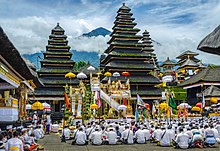
Back বালিদ্বীপীয় হিন্দুধর্ম Bengali/Bangla Balijský hinduismus Czech Balinesischer Hinduismus German Hinduismo balinés Spanish बाली द्वीप में हिन्दू धर्म Hindi Hinduisme Bali ID Induismo balinese Italian バリ・ヒンドゥー Japanese ബാലിയിലെ ഹിന്ദുമതം Malayalam बालीमधील हिंदू धर्म Marathi
| Part of a series on |
| Hinduism |
|---|
 |


Balinese Hinduism (Indonesian: Agama Hindu Dharma; Agama Tirtha; Agama Air Suci; Agama Hindu Bali) is the form of Hinduism practised by the majority of the population of Bali.[1][2][3] This is particularly associated with the Balinese people residing on the island, and represents a distinct form of Hindu worship incorporating local animism, ancestor worship or Pitru Paksha, and reverence for Buddhist saints or Bodhisattava.
The population of Indonesian islands is predominantly Muslim (87.2%).[4] The island of Bali is an exception where about 87% of its people identify as Hindu (about 1.7% of the total Indonesian population).[4]
The 1945 Constitution of Indonesia guarantees freedom of religion to all citizens.[5] In 1952, states Michel Picard, an anthropologist and scholar of Balinese history and religion, the Indonesian Ministry of Religious Affairs came under the control of conservatives who severely constrained an acceptable definition of a "religion".[5] To be acceptable as an official Indonesian religion, the ministry defined "religion" as one that is monotheistic, has codified religious law and added several requirements.[5][1]
Further, Indonesia denied rights of citizenship (such as the right to vote) to anyone not belonging to an officially recognized monotheistic religion.[1] The minority Balinese Hindus adapted and declared their form of Hinduism to be monotheistic, and presented it in a form to be politically eligible for the status of agama. As such, Balinese Hinduism has been formally recognized by the Indonesian government as one of the official religions practised in Bali.[1][5]
- ^ a b c d McDaniel, June (2013), A Modern Hindu Monotheism: Indonesian Hindus as ‘People of the Book’. The Journal of Hindu Studies, Oxford University Press, doi:10.1093/jhs/hit030
- ^ "Sensus Penduduk 2010 - Penduduk Menurut Wilayah dan Agama yang Dianut" [2010 Population Census - Population by Region and Religious Affiliations] (in Indonesian). Badan Pusat Statistik. Retrieved 27 May 2014.
- ^ Saihu, Saihu (30 June 2020). "Local Tradition and Harmony among Religious Adherents: the Dominant Culture of Hindu-Muslim Relation in Jembrana Bali". Wawasan: Jurnal Ilmiah Agama Dan Sosial Budaya. 5 (1): 31–42. doi:10.15575/jw.v5i1.8029. ISSN 2502-3489. S2CID 222901787.
- ^ a b Indonesia: Religions, Encyclopaedia Britannica
- ^ a b c d Cite error: The named reference
picardwas invoked but never defined (see the help page).